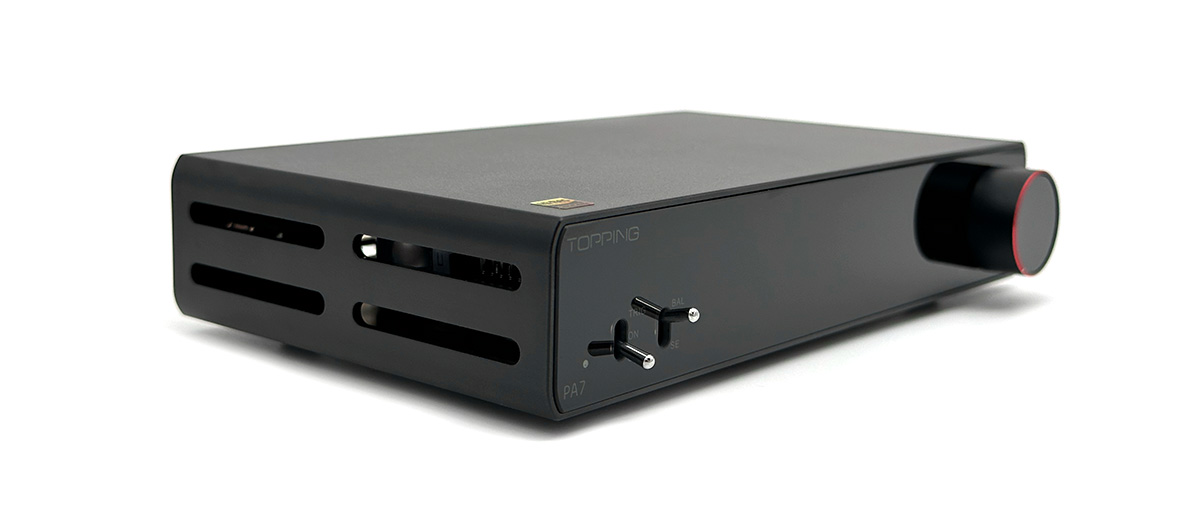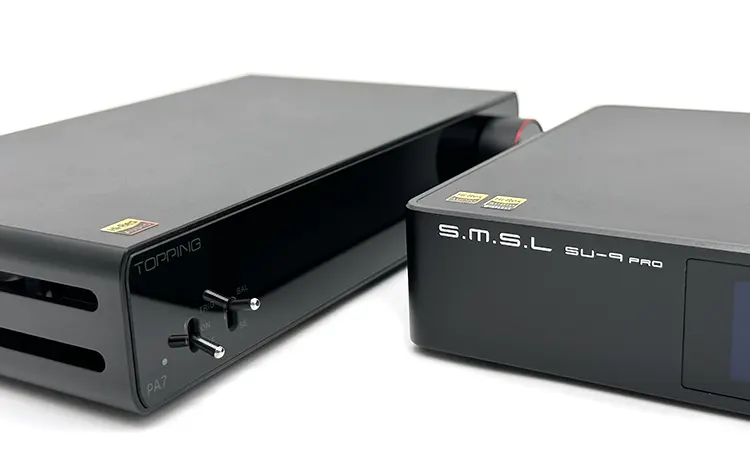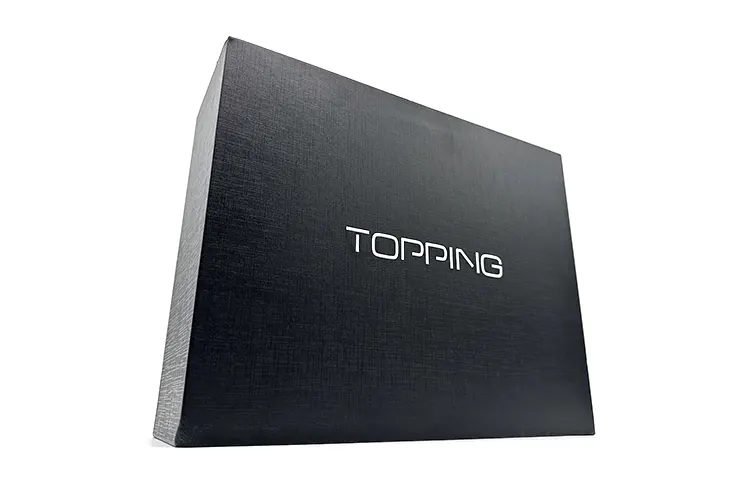Synergy
Power
I’ve always found the 8Ω nominal impedance and 100W recommended input power requirement of my Monitor Audio Silver 50 a tough ask for most desktop mountable power amplifiers out there. Meanwhile, the PA7 and its 150W per channel of output power easily ticked the box.
Continuing with the checklist, I find that cheaper amps tend to produce hiss which can be heard on the tweeters with no music playing. Here the PA7 passed easily, so I went ahead with my listening impressions.
For nearfield setups, the PA7 provides a lot of headroom. Around a quarter of the wheel, maybe a bit more, a comfortable volume is already achieved. This stretched to the noon position when filling up a room and sitting farther on a couch.
Know that there is a slight imbalance in the quieter setting of the volume. It’s easy to miss though since it’s far lower than the useful range I’d use normally.
Pairings
I know the Chord Electronics Qutest is still quite farfetched to most considering the full price it will total to if combined with the PA7. So, considering the caliber of the PA7, and not having the E70 here to pair, I went with SMSL’s SU-9 Pro as a second alternative.
Strictly talking of the timbre, the bass response between the two DACs has given the Silver 50 speakers great projection of scale from the mid-bass down to the lower extremes. The more expensive DAC though is adding a touch more springiness to each swing.
The PA7 can mate with higher-end components as it was able to squeeze a slightly more resolving sound out of the Qutest.
The Chord and Topping pairing provided better separation in the lower frequencies where a tinkling piano remained more composed and not as affected by the lesser definition the SU-9 Pro provides. What SMSL’s DAC provide is less intimacy and lighter weight for vocals while still being fairly melodic.
Violins on the SU-9 Pro setup are leaner with more sparkle. This meant that isolation and placement got a bit of help. The Qutest could be more appealing to some though in focusing on dispersion and scale instead so it is not as tense sounding.
Select Comparisons
SMSL DA-6
Technical
Cheaper the DA-6 may be but for a demanding person, it surprisingly includes a good amount of personalization. With EQ presets and three analog sound modes, users are further spoiled with ±14dB of bass and treble control.
Like the PA7, the DA-6 is also Class-D, but unlike Topping, SMSL discloses that there is an Infineon chip inside. Even at lower loads of 4Ω, the DA-6 is nowhere near the capacity of the PA7 maxing out at 70W per channel.
The DA-6 answers the limitations of the analog volume control of the PA7 by passing the responsibility to an electronic regulator. Having a physical potentiometer though is the way to go if potential signal compression is to be avoided.
Design
A lot smaller than the PA7 but still reasonably hefty enough to stay in place, one good thing going for the DA-6 if space is a problem, is its compact chassis. It also features a display and receiver so operating it from afar through the included remote is a baked-in feature.
Comparing the volume wheel though is a trickier situation. The PA7 in staying analog has nicer sweeping feedback, unlike the one on the DA-6 which is small and cheaper feeling. In adding a multifunction knob though, the DA-6 was able to add more functions and remove the need for toggle switches used by Topping.
Performance
More soft and playful than the PA7, the DA-6 easily excites and fills a room with bolder bass emphasis. But while it does have a nice presentation, switching back and forth with the more expensive amp makes it obvious that Topping is the more mature unit.
Both add girth to the reverb of bass strings although it is the DA-6 that tends to blur with neighboring objects. The PA7 has a more linear and agreeable sound for those looking for more honesty and cleaner notes.
It seems as well that the DA-6 manages object placement less accurately since pitchy singers tend to push the envelope more but then guitar strings sometimes play farther back. I’ll hold the pa7 for its superior truthfulness in any type of song. Considering this though, the PA7 when compared to the DA-6 sounds a little bit more laidback.
The DA-6 has livelier electric guitars and yet sounds more compressed than the PA7 missing a lot of the details. Dynamics and definition are the two biggest things I’d say choosing the PA7 will get you.
Burson Funk
Technical
It’s not hard to find a power amplifier that has a headphone jack out front, what’s hard is to get one in the footprint of the Funk while at the same time boasting Class-A internals and user-replaceable op-amps.
This mix of accomplishments puts the Funk ahead for now but the PA7 is not going to get left behind as a pure book-sized speaker amplifier.
Looking at the inputs first, the Funk has a lonelier set of connections available since it can only pair with single-ended sources. The PA7 opens options to more sources especially balanced ones since aside from XLR, it can also couple through TRS.
Designed for nearfield listening, the Funk is rated at a lower 45W per channel. Owners of inefficient speakers or simply those looking to listen in a far-field setup may find the volume wheel of the Funk running a bit short.
Design
To look at the PA7 and Funk side by side, it is easy to tell that the Funk has more personality. The heatsink chassis of the Funk is used by Burson pretty much everywhere even with their much pricier products. It is ‘cool’ to experience this with their most inexpensive device.
Topping is more dynamic with the designs of their products but at least for the PA7, it stayed close to the neatness of the E70 as its official combo.
Both units do not have a screen, instead, they rely on buttons and switches plus some help with LEDs for feedback.
Replacing the input switch of the PA7 on the Funk is a button for selecting between headphone and speaker output. When set to output through the front, the Funk has a third button for changing the gain.
Performance
Taking a different approach to coloring the sound, the Funk is directionally in the bigger and bolder category where the weight and warmth of each note are easy to see from the start.
This may be the case but one thing I always nitpicked about the Funk in its stock configuration is its lack of sub-bass which the PA7 easily outperforms. Sure, owners can swap it with Burson’s V6 op-amps which I can confirm solves this complaint but doing so adds to the cost of ownership.
The sweetness continues to the midrange where instruments and vocals don’t appear as lightweight as the PA7. There is a bit more texture here on breathier portions of a song. In relation, the PA7 staggers a bit in providing the same refinement as some parts can emerge more smoothed out.
Female singers are more favored by the Funk in a duet offsetting one in front of the other overpowering the male to not be as persuasive. The PA7 did a better job of bringing the two singers to the same plane.
Rock songs have so much more character in the Funk with trebly notes fleeting more than the PA7 which is a bit rigid when compared. The Funk is showing a mix of fluidity and resolution which is only disturbed at times by its stronger elevation.
Our Verdict
The Topping PA7 may lack the same boldness suggested by the power rating it has in reserve, but in any case, it still has proven itself to be a stunner.
There’s nothing much to complain about the PA7 as you may know by now. If anything, I would have wanted to know more about what is actually inside the chassis. As it is, the only accomplishment of the PA7 is its 210W output power and some extra features like the 12V trigger and XLR/TRS input.
I honestly don’t think the tuning will be too much of a hassle to pair especially with the bolstered low-end that cheers up the mood.
Topping PA7 Technical Specifications
- THD+N @1kHz (A-wt) SE: <0.0005% @4Ω 20W, <0.0004% @8Ω 20W, THD+N @1kHz (A-wt) BAL: <0.0004% @4Ω 20W, <0.0003% @8Ω 20W
- THD+N @20kBW (No-wt) SE: <0.009% @4Ω 20W, <0.004% @8Ω 20W, THD+N @20kBW (No-wt) BAL: <0.009% @4Ω 20W, <0.004% @8Ω 20W
- SNR @Max out 1kHz SE: 123dB, SNR @Max out 1kHz BAL: 126dB
- Dynamic range SE: 123dB, Dynamic range BAL: 126dB
- Frequency response SE: 20-40kHz (±1.5dB), Frequency response BAL: 20Hz-40kHz (±0.3dB)
- Output level SE: 83Vpp @4Ω, 89Vpp @8Ω, Output level BAL: 83Vpp @4Ω, 89Vpp @8Ω
- Noise (A-wt) SE: <17uVrms, Noise (A-wt) BAL: <17uVrms
- Channel crosstalk @1kHz SE: -96dB, Channel crosstalk @1kHz BAL: -116dB
- Input sensitivity SE: 1.9Vrms, Input sensitivity BAL: 3.8Vrms
- Gain SE: 25.7dB, Gain BAL: 19.8dB
- Channel balance SE: 0.5dB, Channel balance BAL: 0.5dB
- Output power (THD+N<10%): 210W x2 @4Ω / 150W x2 @8Ω
- Output power (THD+N<1%): 200W x2 @4Ω / 125W x2 @8Ω
- Load impedance: 4-8Ω





